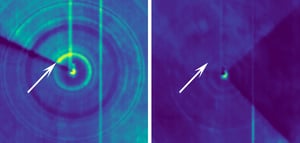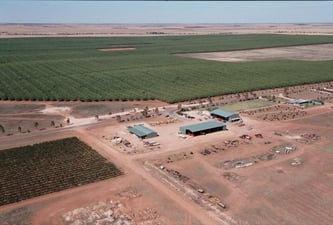
You could say we were made from water: Ceres Imaging got its start helping California almond growers navigate a severe drought. Though we've expanded our services since then, finding and solving irrigation problems remains a top use of our imagery and analytics. We're marking Smart Irrigation Month with a look at three different ways we've partnered with growers to dial in their irrigation programs.
Spotting pivot problems in North Dakota potatoes
Potatoes are notoriously water-sensitive: University of Idaho Extension research has found that “over-irrigating by 20 to 30 percent during the growing season can reduce potato yield, quality, and fertilizer use efficiency”—lowering returns by more than $150 an acre.
When Ceres Imaging flew over these pivot-irrigated potatoes in central North Dakota, we found irrigation issues in a quarter of the operation's fields. The early-season thermal imagery here is one example: the yellow ring reveals underwatering caused by a clogged sprinkler nozzle. It’s a straightforward fix once the problem is identified, but the temperature difference that tipped us off to the irrigation problem is imperceptible to a grower on the ground.

“If you have any kind of water stress in potatoes, it can lead to fry color problems in french fries,” says agronomist John Vaadeland. “Ceres Imaging helped us to detect irrigation issues we couldn’t visually see early in the season.”
Tackling tough terrain in California almonds
Winters Farming takes its infrastructure seriously, investing in a drip irrigation monitoring and control system and a catch reservoir. The commitment to smart irrigation pays off: farm manager Alex Bergwerff reported to PrecisionAg that the operation can get up to 4,000-pound crops out of its trees.
But even for expert growers, variable terrain can present a challenge. When trees on a recently acquired parcel of land showed signs of stress, Bergwerff used imagery to pinpoint and quickly remedy an issue with pressure-sustaining valves in the irrigation system.
"It’s the big ones that you need to jump on the fastest," Bergwerff says. "It's so much quicker to find these sorts of issues with imagery."
Designing tailor-made systems in Australia

A 1,000-acre expansion was good news for Century Orchards in Australia—but the additional land came with pressure to make sure the investment paid off.
We worked with farm managers to analyze aerial imagery and design an irrigation system that could support consistent, high yields—even in the variable conditions of the larger operation. In places where imagery revealed malfunctions in automated systems, repairs were more efficient, with less times spent hunting for problem areas and lower labor costs as a result.
Have you used aerial imagery to irrigate smarter? Leave us a comment, or drop us a line at social@ceresimaging.net.